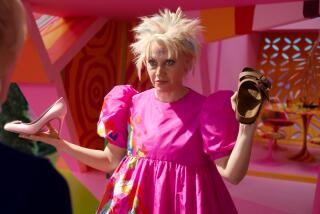Opinion: Are you sure your daughter should dress up as a princess this Halloween?
If you have little girls in your life, chances are you know a thing or two about princesses. And as Halloween approaches, your little Belles or Cinderellas will take their fairy tale parading from their living rooms to the sidewalks in search of candy.
For parents, especially parents of girls, it’s really hard to ignore the power of princess culture. Princesses are an ubiquitous part of contemporary girlhood. And it may look as if it’s all in good fun, but beneath the tulle and tiaras are harmful messages about beauty standards, gender, romantic relationships and race. Which is why children’s media scholar Rebecca Hains’ new book “The Princess Problem” is such a beacon of light for parents trying to navigate through the fog of their daughter’s princess obsessions.
So what’s wrong with princess culture? The problem, Hains says, is not necessarily with children playing princess. Fairy tales with princesses have been around forever, and children have been reading and acting out these stories just as long as they’ve existed. What is new is how corporations like Disney have co-opted princess play and then embedded a regressive set of gender and race ideals into their products. These companies spend billions of dollars aggressively marketing products to girls resulting in what Hains calls “a kind of myopic monochromatic girlhood.”
Critics have long taken issue with the content of princess movies. Disney princesses are a particularly easy target. Not only do most of the movies center around being saved by a prince charming and getting married, but the princesses are also usually as Hains puts it: helpless, weak, skinny, buxom and almost always white. Slate’s Amanda Marcotte wrote that Elsa, the Disney heroine from the currently wildly popular film “Frozen,” has “eyes that are bigger than her wrists.” Disney introduced its first African American princess, Tiana, in 2009’s “The Princess and the Frog” and a more progressive storyline with Merida in 2012 with “Brave,” but both of these characters are still model-skinny.
Beyond the content of the movies is the question of how these marketing messages may shape what kids see in themselves and the world. Experts, including the American Academy of Pediatrics, suggest that the games children play are essential to childhood development. But a lot of play these days is influenced in one way or another by media. The Campaign for a Commercial-Free Childhood says children ages 2 to 11 see more than 25,000 advertisements a year on TV alone. And advertisers are spending billions on children’s marketing, so kids aren’t just being targeted, they’re being skillfully bombarded.
The Disney princess franchise specifically, as Hains notes in her book, is the No. 1 brand in the United States and Canada, selling $1.52 billion in 2012. From flower seeds to chicken noodle soup, you can get pretty much anything with a Disney princess on it.
But princess marketers, Hains says, have also figured out how to exploit a moment in childhood development when kids are figuring out what gender means to themselves and society. Kids naturally look to our culture to make sense of everything, including what it means to be boys and girls. But when they see the kind of stereotypical marketing that is rife in princess culture, it can have a detrimental effect. Experts like Hains say that seeing these types of messages can lead to a rigidity in which kids not only refuse to play with children of the opposite sex but also refuse to play with any toy that does not fall into the appropriately marketed gender category.
I don’t want to participate in parent judging or princess shaming here. But it’s both overwhelming and infuriating to feel as if we’re up against a multibillion-dollar industry that has a mission to sell our child a particular type of fantasy. What concerns me most about princess culture is the way it perpetuates the policing of what it means to be a boy or a girl.
The answer isn’t necessarily to forbid the princesses but to have a dialogue with them about what they love and why. In a world fraught with problematic media messages, parents don’t have to be passive bystanders. Hains’ book offers concrete tips, from introducing a variety of toys beyond the princess centric to working with your child on creating a healthy media diet. Most important, Hains says you should “watch and talk about the media with your child.”
Ultimately it’s not just about guiding kids through immediate childhood fixations but about giving them the tools they’ll need to become savvy media consumers. That way they can live happily -- and intelligently -- ever after.
Susan Rohwer is a freelance journalist. Follow her on Twitter @susanrohwer.
Follow the Opinion section on Twitter @latimesopinion
More to Read
A cure for the common opinion
Get thought-provoking perspectives with our weekly newsletter.
You may occasionally receive promotional content from the Los Angeles Times.






